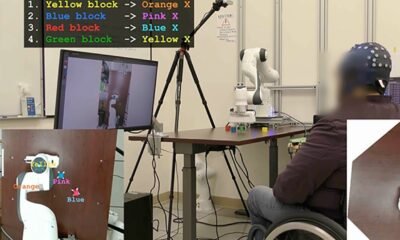Top Stories
Scientists use DNA from three people to protect babies from rare disease

LONDON – A pioneering IVF technique combining DNA from three people to protect a baby from a rare genetic disease has been used in Britain, leading to a healthy cohort of eight babies with no sign of serious disease, scientists said Wednesday.
Four girls and four boys, including one set of twins, were born healthy after scientists used the treatment to prevent mothers with mutations in their mitochondrial DNA from transmitting the condition to their children, scientists at Newcastle University in northern England said in a statement Wednesday.
The authors say it represents the first study into an entire cohort of babies and paves the way for further research on their health outcomes, as well as improved medical techniques for that specific treatment – which is granted approval in the United Kingdom on a case-by-case basis.
Mitochondria are commonly known as the “powerhouse of the cell” and produce energy required for major parts of the body to function. However, small mutations in mitochondrial DNA can affect tissues with high-energy demands such as the heart, muscle and brain, causing devastating disease and, in some cases, death.
Mitochondrial DNA is inherited from the mother, and although males can be affected, they do not transmit the disease, researchers said. About 1 in 5,000 babies are born worldwide each year with mutations that can cause the disease, researchers said.
Now, scientists have detailed how an IVF technique called pronuclear transfer has been used to combine the DNA of three people to reduce the risk of mitochondrial disease being passed down the generations, in accompanying studies published in the New England Journal of Medicine on Wednesday.
The technique uses 99.9 percent of the DNA from a man and woman, with another 0.1 percent from a second woman’s donor egg. It works by transplanting the nuclear genome of an egg from the mother with the condition – which contains genes essential for individual characteristics like hair color and height – to an egg donated by an unaffected woman that has had its nuclear genome removed, researchers said.
The resulting embryo inherits nuclear DNA from its two parents, but the mitochondrial DNA comes from the donated egg, researchers said. The treatment was offered to certain women at very high risk of passing on serious mitochondrial disease, in accordance with U.K. regulations that assess each application for the procedure on a case-by-case basis.
The eight infants – who range in age from newborn to over 2 years old – were assessed to be healthy, meeting developmental milestones and reported levels of mitochondrial disease-causing mutations that were undetectable or at levels unlikely to cause disease, the Newcastle University statement said. Three of the babies had levels of disease-causing mitochondrial DNA mutations of up to 20 percent, which is still below the 80 percent threshold for clinical disease, it added.
Doug Turnbull, a neurologist at Newcastle University who co-wrote the study, said it was the first to document a “cohort” of children who had received the treatment. He said it is the result of an extremely cautious approach by scientists and regulators that has been more than two decades in the making.
“People have used very similar techniques, but nobody’s quite used this particular technique,” he told The Washington Post in a phone interview Thursday. “It’s just absolutely critical when you’re doing a new technique to be cautious and to make sure … it’s as safe and efficient as possible.”
The procedure has also raised concern from some, including religious groups, about its ethics and the fear that it could open the door to further genetic modification.
Peter Thompson, chief executive of the Human Fertilization and Embryology Authority, which regulates the process in Britain, said that only people with a “very high risk” of passing on a serious mitochondrial disease are eligible for the treatment and that every application is assessed individually. As of July 1, 35 patients have been granted approval by U.K. authorities to proceed with the treatment since it was first licensed in 2017.
“These robust but flexible regulatory processes allow the technique to be used safely for the purposes that Parliament agreed in 2015,” Thompson said in a statement in response to Wednesday’s news.
Scientists have cautiously welcomed the findings, while stressing the importance of long-term monitoring and raising the prospect of whether the procedure offers advantages over embryo screening for genetic disease. Others have raised the issue of cost in the long-term project that is supported by Britain’s National Health Service and medical charity the Wellcome Trust, among other groups.
Mary Herbert, who is professor of reproductive biology at Newcastle University and lead author of the research paper, said “the findings give grounds for optimism” but further research is needed to “bridge the gap” between reducing risk of mitochondrial disease and preventing it.
Turnbull said the team is also looking to improve medical techniques and follow up with the children involved for as long as possible to track their health outcomes. He said researchers are offering health assessments for five years, but it “would be lovely to be able to follow them up much longer.”
Joanna Poulton, a professor in mitochondrial genetics at the University of Oxford, who was not involved in the research, said “time will tell” whether the treatment results in “dramatic clinical advance.”
The births come amid a wider boom in genomic sequencing and IVF start-ups that have sparked a wider debate about the ethics and science behind embryo screening and genetic preselection.
In the United States, those undertaking IVF typically test for rare genetic disorders stemming from a single gene mutation, such as cystic fibrosis, or chromosomal abnormalities such as Down syndrome. The use of donor mitochondria, however, is not permitted under U.S. regulations. In Britain, the creation of babies using DNA from three people was first made legal in 2015, hailed for its ability to prevent serious disease being passed on.
Related Content
An asylum seeker abandons her claim and leaves Trump’s America
He may have stopped Trump’s would-be assassin. Now he’s telling his story.
He seeded clouds over Texas. Then came the conspiracy theories.
Top Stories
Ukraine war briefing: Poland’s allies decry ‘flagrant violation’; Warsaw sends troops to border to monitor Belarus drills | Ukraine

Poland and about 40 of its allies on Friday denounced the intrusion of Russian drones into its airspace this week, calling on Moscow to avoid more “provocations”. Before an emergency meeting of the UN security council requested by Poland, deputy foreign minister Marcin Bosacki told reporters that Warsaw and its allies wanted to “draw the attention of the international community to yet another flagrant violation of international law and the Charter of the United Nations committed by the Russian Federation”, which had brought “the entire region closer to conflict than at any time in recent years”. The comments were from a statement signed by about 40 countries, including the 26 other members of the European Union, Ukraine, the United States, Japan and Canada. “We take this opportunity to reiterate our call on the Russian Federation to immediately cease its war of aggression against Ukraine, to renounce any further provocations, and to respect its obligations under the UN Charter,” he said. “Escalation cannot lead to peace.”
France, Germany and Denmark will contribute fighter jets and other military assets to an enhanced defence of Poland against future Russian drone incursions, Nato leaders announced at a press conference on Friday. The UK is also expected contribute to the Eastern Sentry mission, which will gradually be expanded from the Arctic in the north to the Black Sea and Mediterranean in the south to better tackle Russian drones and missiles.
The latest blow to faltering diplomacy came as Russia’s army staged major military drills with its key ally Belarus. The military drills started on Friday, and include exercises close to the border with Poland and Lithuania and in the Baltic and Barents seas. Russia’s defence ministry posted a video showing heavy military equipment – including armoured vehicles, helicopters and navy ships – taking part in the drills. Poland said it would station about 40,000 troops near the Belarus border for the duration of the drills.
Prince Harry laid a wreath at a flower and flag memorial to Ukraine’s war dead in Kyiv’s Maidan Square during a surprise visit to support the country in its fight against Russia, saying he wanted to do “everything possible” to help the thousands of military personnel who have been seriously injured in the war against Russia. During the trip to Kyiv, Harry and a team from his Invictus Games Foundation gave details of new initiatives to support the rehabilitation of the wounded, with the eventual aim of providing help to all areas of the country.
Russia said peace talks with Ukraine were on “pause” as President Volodymyr Zelenskyy warned that Vladimir Putin still wanted to capture the whole of Ukraine. “Our negotiators have the opportunity to communicate through channels. But for now, it is probably more accurate to talk about a pause” in talks, Kremlin spokesman Dmitry Peskov told reporters. Speaking at a conference in Kyiv, Zelenskyy said the west should not trust Putin. “Putin’s goal is to occupy all of Ukraine. And no matter what he tells anyone, it is clear that he has set the war machine in motion to such an extent that he simply cannot stop it unless he is forced to fundamentally change his personal goals,” he said. The Ukrainian president also called on allies to encourage China to use its leverage with Russia to stop Moscow’s offensive.
Trump told Fox television his patience was being taxed by Russia’s refusal to end its invasion. “It’s sort of running out and running out fast, but it does take two to tango,” Trump told Fox television. “It’s amazing. When Putin wants to do it, Zelensky didn’t. When Zelensky wanted to do it, Putin didn’t. Now Zelensky wants to and Putin is a question mark. We’re going to have to come down very, very strong,” he added. The Ukrainian president has long been open to efforts to meet and agree a ceasefire.
Top Stories
Canelo Alvarez-Terence Crawford fight, odds: 1 bettor wagers $2 million on Terence Crawford to win

Terence Crawford and Saul “Canelo” Alvarez square off on Saturday at Allegiant Stadium in Las Vegas in one of the biggest fights of the year.
Several bettors will have a very large rooting interest.
Advertisement
A bettor at BetMGM wagered $2 million on Crawford to win the fight at +140 odds on Friday night. The wager would win $2.8 million and is the largest reported wager on the fight.
One bettor at Caesars Palace in Las Vegas also wagered $715,000 on Crawford to win the fight at +140 odds, which would win just over $1 million ($1.001 million to be exact). Other sportsbooks have taken six-figure wagers on Crawford as well.
“We just took a very large bet on Crawford to win and by KO,” Andrew Babakitis, risk manager at the Westgate Las Vegas Super Book, told Yahoo Sports via text message on Friday afternoon. “Price moved from -180 to -160 on Canelo. We have three times as many bets on Crawford. Book loses on both fighters by KO, we are likely going to need a decision if we want to win on the fight.”
Advertisement
Alvarez opened as a -200 favorite at BetMGM, but is down to -150 on the three-way line, while Crawford opened as a +175 underdog and is currently +150. While only 23% of wagers are on Alvarez to win, nearly half the total dollars wagered (42%) at BetMGM are on Canelo, while the betting public is backing the underdog, with 33% of wagers on Crawford to win.
Nearly half the bets (44%) and total dollars wagered (44%) were on a tie, as of Friday morning.
Top Stories
ICE agent shoots dead man who tried to drive at agents, officials say

US immigration and Customs Enforcement (ICE) shot and killed a man near Chicago on Friday after he allegedly drove his car at a group of agents.
A spokesperson for the Department of Homeland Security said ICE was trying to arrest the man, but he resisted and drove towards the group. An agent was then dragged along by his vehicle.
The agent, who the department said feared for his life, drew his gun and opened fire.
The driver, Silverio Villegas-Gonzales, was pronounced dead in hospital shortly after, officials said.
“During a vehicle stop, the suspect resisted and attempted to drive his vehicle into the arrest team, striking an officer and subsequently dragging him as he fled the scene,” the statement said.
The ICE agent suffered “severe injuries” in the incident, officials said, but was in a stable condition in hospital.
The Department of Homeland security said Mr Villegas-Gonzales had a history of reckless driving and was an undocumented migrant. He entered the country “at an unknown date and time,” they said.
A spokesperson for the local police department in Franklin Park said they were not involved in the incident.
Illinois Governor JB Pritzker said in an online post: “This is a developing situation and the people of Illinois deserve a full, factual accounting of what’s happened today to ensure transparency and accountability.”
Franklin Park is a suburb of around 18,000 people near O’Hare Airport north-west of Chicago. Around half of the population of the village is Hispanic.
Immigration officials have been ramping up enforcement activities in the Chicago area this week on the orders of the Trump administration.
-

 Business2 weeks ago
Business2 weeks agoThe Guardian view on Trump and the Fed: independence is no substitute for accountability | Editorial
-
Tools & Platforms1 month ago
Building Trust in Military AI Starts with Opening the Black Box – War on the Rocks
-

 Ethics & Policy2 months ago
Ethics & Policy2 months agoSDAIA Supports Saudi Arabia’s Leadership in Shaping Global AI Ethics, Policy, and Research – وكالة الأنباء السعودية
-

 Events & Conferences4 months ago
Events & Conferences4 months agoJourney to 1000 models: Scaling Instagram’s recommendation system
-

 Jobs & Careers2 months ago
Jobs & Careers2 months agoMumbai-based Perplexity Alternative Has 60k+ Users Without Funding
-

 Podcasts & Talks2 months ago
Podcasts & Talks2 months agoHappy 4th of July! 🎆 Made with Veo 3 in Gemini
-

 Education2 months ago
Education2 months agoVEX Robotics launches AI-powered classroom robotics system
-

 Education2 months ago
Education2 months agoMacron says UK and France have duty to tackle illegal migration ‘with humanity, solidarity and firmness’ – UK politics live | Politics
-

 Podcasts & Talks2 months ago
Podcasts & Talks2 months agoOpenAI 🤝 @teamganassi
-

 Funding & Business2 months ago
Funding & Business2 months agoKayak and Expedia race to build AI travel agents that turn social posts into itineraries



















